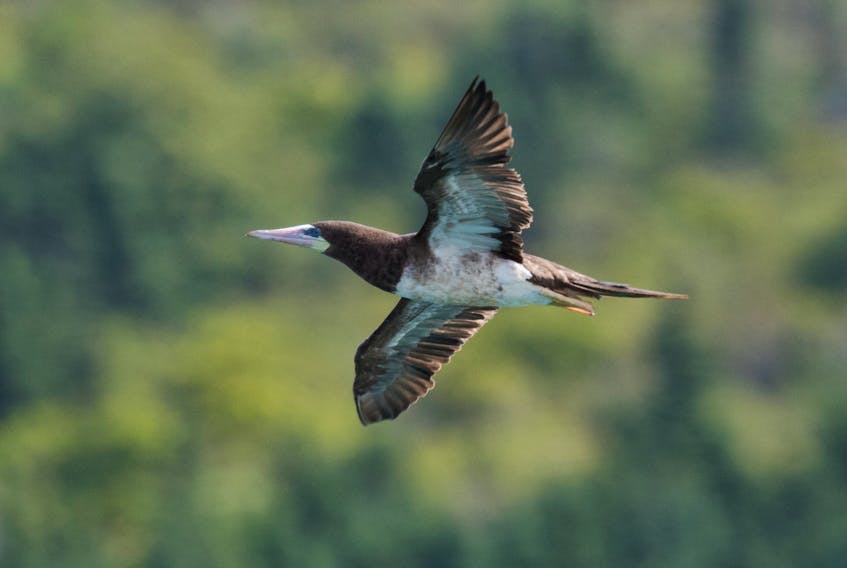The year 2019 will well be remembered by Newfoundland birdwatchers. It will be the year to compare the rest with.
Every year is full of surprises and great pleasures but 2019 was bursting with great moments and exciting birds that can hardly be touched upon in this 800-word column. In recent years the annual number of species found on the island of Newfoundland is about 270. In 2019 that total topped 290 species!

January started off with birders trying to get views of the rare red-tailed hawk that made Signal Hill, St John’s its winter home. Others felt the Siberian visitor, a slaty-backed gull, found at Quidi Vidi Lake on Jan. 17 and stayed into early February was the star attraction of the winter.
Overwintering northern cardinals at bird feeders on the Burin Peninsula at Lewin’s Cove and Lawn, plus another at Pouch Cove on the Avalon Peninsula added spice to the winter.
Winter ended with a strong showing of the spectacular white gyrfalcon from the Arctic.
Spring is but a drawn-out version of the winter season.
Birders found some spark in the humdrum weather with Icelandic visitors in the form of a European golden-plover and black-tailed godwit in the Goulds, and one of the rarest birds of the year, a Eurasian oystercatcher that spent over a week at Lushes Bight starting on May 15. This was just the fourth Eurasian oystercatcher sighting in Newfoundland and North America.
A splendid drake redhead duck was a surprise in Mundy Pond, St. John’s in early May. A May 29 painted bunting was but a one day teaser at Stephenville.
Summer is anything but a slow season for birding in Newfoundland.
A male ruff still in full breeding plumage regalia was a summer treat at Branch on June 25. A common redshank on July 10 was a completely unexpected discovery of this European shorebird at St. Vincent’s beach. The usual swarms of seabirds reacting to the caplin spawning season was enough to entertain birders for a large part of the summer.
The fall of 2019 was nonstop birding action. A roseate tern at Trepassey Sept. 3-6 was a nice find. Rare southern warbler action started with a flashy prothonotary warbler at Trepassey on Sept. 5. The off-the-wall bird of the year was the brown booby discovered resting on the mast of ship tied up to the dock in St. John’s harbour on Sept. 7. It remained for two hours allowing for a small mass of birders and curious waterfront onlookers to assemble and see this highly pelagic, subtropical seabird. Several more were sighted from vessels well offshore in southern Newfoundland waters over the summer.
Hurricane Dorian was the ornithological event of the year. The storm that carried a tanker load of exotic birds from Cape Hatteras, North Carolina to Nova Scotia only brushed by southwestern Newfoundland but left an indelible mark on the province.
An incredible total of eight gull-billed terns as well as a few royal, sandwich, black and Forster’s terns and the province’s first ever marbled godwit were found by eager observers in Newfoundland.
September and October finds Avalon Peninsula birders in the alders digging hard for southern warbler vagrants.
There was no one particular weather system obviously responsible for the high number of bird strays from the south and southwest that reached Newfoundland throughout these two months. There were white-eyed vireos, summer tanagers, scarlet tanagers, plenty of lark sparrows and dickcissels, yellow-billed cuckoos, prairie warblers, yellow-breasted chats – it was a smorgasbord of delectable Newfoundland rarities.
November is a month of cream skimming for the rarities left behind after the main fall migration period. They become more exposed in the cooler conditions. Record high numbers of pine warblers, orange-crowned warblers and other birds was a strong sign something unusual was happening. The fourth provincial occurrence of Bullock’s oriole was at a Kelligrews bird feeder for three weeks.
But nothing compares to the Townsend’s warbler event of the fall of 2019 which climaxed in November. The 18 different Townsend’s warblers found on the Avalon Peninsula during the fall was far more than any province or state east of the Rocky Mountains has recorded in their entire history. While everyone was scratching their heads trying to figure out how can this happen, an even rarer hermit warbler was found on Dec. 7 in the pines planted around the old School for the Deaf in St. John’s. From the west coast of the United States, this was amazingly the fourth record of hermit warbler for the province. It is currently living off offerings of suet and peanut butter and is expected to carry over into the New Year
Just before the year runs out a rare European thrush called the redwing was found in a Tors Cove robin flock. 2020 will carry on fast and furious just where 2019 left off.
May 2020 be full of birds for us all.
Bruce Mactavish is an environmental consultant and avid birdwatcher. He can be reached at [email protected].
RELATED:









